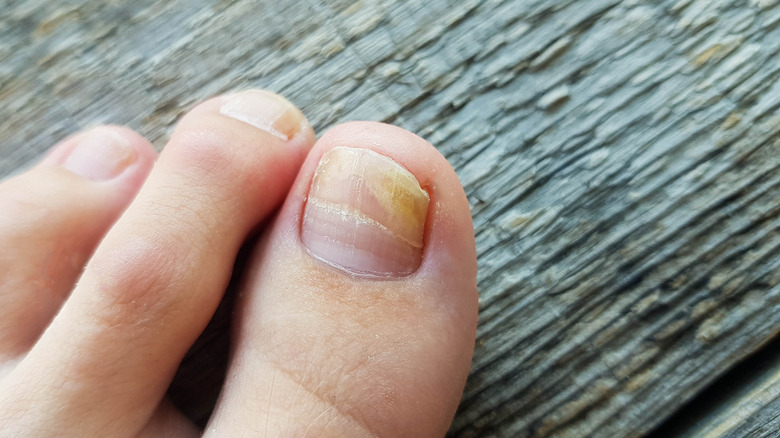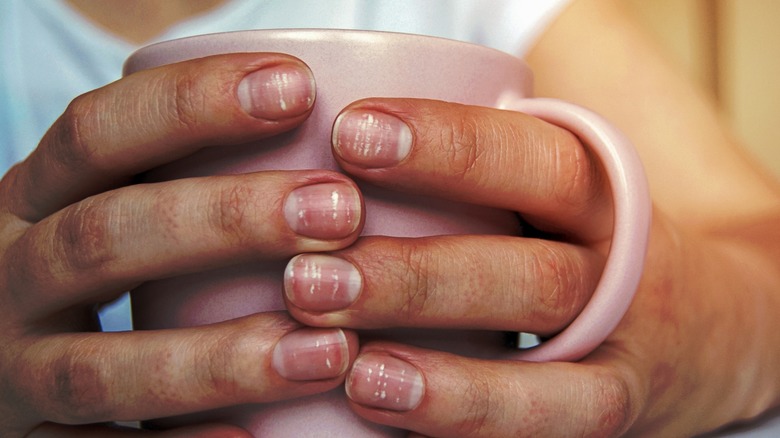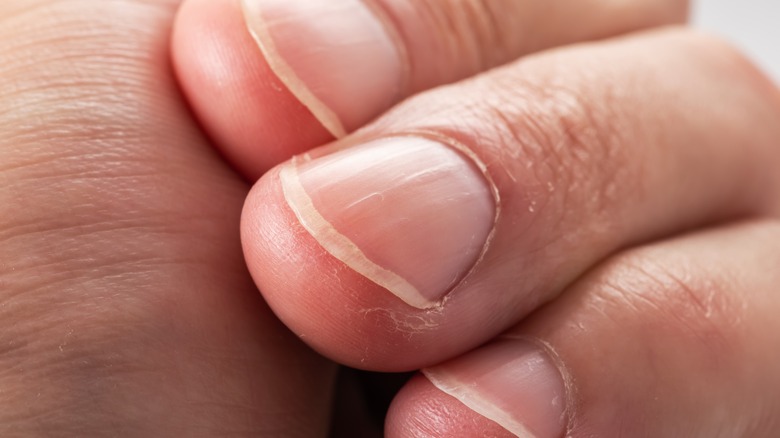Health Secrets Your Nails Are Trying To Tell You
If you're someone for whom regular manicures are a non-negotiable, you may want to consider going nail polish-free every now and again to take a deeper look at what might be going on below the surface.
While the appearance of our nails may vary somewhat — particularly if the nail has recently suffered an injury — we generally want our fingernails to appear smooth in texture, free of any indentations, and to be a singular color. Made of keratin, our fingernails grow approximately 3.47 millimeters a month, according to findings from a small 2010 study published in the Journal of the European Academy of Dermatology & Venereology. This is considerably faster than our toenails, which were found to grow roughly 1.62 millimeters per month. Similar to our fingernails, healthy toenails should appear smooth in texture and be a shade of light pink. Any changes in nail color, texture, shape, pattern, or growth rate may not initially seem like a big deal, but can potentially indicate a health problem. Here are the secrets your nails may be trying to tell you, so you'll want to listen closely.
Yellow nails may signal a fungal infection or health condition
Nail discoloration is one clue that can tell us a lot about our health. If your nails have started to take on a yellow hue, it may be a sign that you've contracted a fungal infection, reports the American Academy of Dermatology (AAD). Men, older adults, people with certain health conditions, or those who live in more humid climates tend to be at greater risk for the condition, medically termed "onychomycosis," according to 2014 research published in PLoS Pathogens. More often seen in the toenails than the fingernails, these stubborn fungal infections can be tricky to treat once they've set in and may require long-term combination treatment with topical medications, drugs, or surgery.
Nail yellowing may also be tied to certain health conditions, like rheumatoid arthritis, lung disease, or yellow nail syndrome. Cleveland Clinic experts explain that yellow nail syndrome, although rare and not entirely understood, may be related to blood flow problems or fluid buildup. In addition to developing yellow nails, those with the condition often experience breakage, thickening, and curving of the nails. Sometimes, however, yellow nails may simply be the result of painting your nails red without first applying a base coat.
The meaning of other nail color changes
Other health conditions that can produce some funky nail color changes include anemia, which can cause our nails to look pale (via AAD). Alternatively, blue nails may indicate a lack of oxygen in our blood. White nails may be a symptom of diabetes or liver disease, while Weil Foot & Ankle Institute points out that white toenails, in particular, may potentially indicate a protein or calcium deficiency. Additionally, bleeding due to nail injury may cause toenails to turn black or purple. If you haven't recently stubbed your toe, however, purplish-black toenails could alternatively be related to a bacterial infection, B vitamin deficiency, or in rare instances, cancer.
Our nails can also take on multiple colors at once. For example, nails that appear half white and half pink may be a sign of kidney disease. If you notice only partial nail discoloration, such as a dark red spot in the shape of a crescent moon, this could signal arthritis, heart disease, lupus, or more. Similarly, a blue crescent moon-shaped spot could be a symptom of poisoning, such as in the case of argyria, or silver poisoning, which can cause skin and nails to take on a bluish tint (per Cleveland Clinic).
What it means when your nails develop a pattern
If you've noticed your nails have developed a pattern, they may be trying to tell you to give your doctor a call, particularly if that pattern takes the form of dark streaks. The AAD reports that a dark, vertical streak that develops down one's fingernail or toenail may be a sign of melanoma. Early detection is key in treating this serious form of skin cancer. According to the Skin Cancer Foundation, it is estimated that the U.S. will see more than 200,300 new cases of melanoma in 2024.
Alternatively, a condition known as "leukonychia" may cause your nails to develop a white, spotted pattern (per Cleveland Clinic). Usually the result of nail trauma, these small white spots can also emerge due to allergies, a fungal infection, or the use of certain medications. For example, it's reported that chemotherapy drugs may potentially affect our nails. In rare instances, white nail spots may be related to certain health problems, such as diabetes, heart failure, liver cirrhosis, or a nutrient deficiency. Heavy metal poisoning has also been linked with leukonychia. If it's due to nail trauma, medical treatment is not usually needed. Otherwise, consult with your healthcare provider who can help determine whether your spotted nails may be related to a health condition.
What your nails are trying to tell you if they have ridges
What nail ridges can tell us about our health depends on which way they're running. Vertical ridges that run the length of the nail, also known as "trachyonychia," can be expected as we grow older as the nail becomes progressively weaker. If aging isn't responsible for your vertical fingernail ridges, Prevention explains that these textural changes may instead be related to dehydration, nutritional deficiencies, eczema, thyroid disease, or alopecia.
Oppositely, if your fingernail ridges run the width of your nail, these are called "Beau's lines." More often than not, these ridges are the product of nail injury, which can include anything from dropping something heavy on your hand to overdoing it on your cuticle maintenance. Beau's lines related to physical trauma are usually temporary. The same is true for horizontal ridges related to stress, which can temporarily halt nail growth, resulting in Beau's lines. In fact, nearly anything that interrupts nail growth can potentially produce Beau's lines. This was evidenced in a small 2005 study published in High Altitude Medicine & Biology, in which researchers found the incidence rate of Beau's lines was 33% in participants who ascended a mountain in the Himalayas. Dubbing this phenomenon "Everest nails," the researchers determined that the reduced oxygen levels experienced at high altitudes were enough to disrupt nail growth and produce Beau's lines. In some cases, however, horizontal ridges may be related to fever, illness, kidney disease, or more.
Health secrets related to nail swelling
If the skin surrounding your nail has become red, irritated, and swollen, it likely indicates an infection, which is known as "fingernail paronychia." All it takes is plucking a hangnail too harshly or even soaking your hands in water for too long for this kind of skin damage to occur, reports Nemours KidsHealth. While it is not usually cause for concern, medical treatment may be warranted in the event that abscesses or open sores form around the nail. This can make it easier for bacteria or fungus to make their way into the body and increase the risk of the infection spreading, although it is highly unlikely.
Having clubbed nails, or curved nails, is another health condition that may prompt swelling in the fingertips (per AAD). While sometimes just a harmless product of our genes, clubbing has also been seen in connection with medical problems of the liver, heart, lungs, stomach, or small intestines. Curvature of the nails is often the first sign of clubbing and nails may eventually begin to feel spongy to the touch.
Although nail changes are not always indicative of a health condition, talk to your doctor if you notice any concerning symptoms. Our nails may not be able to talk, but as we've learned, that doesn't mean they don't have secrets to tell.






